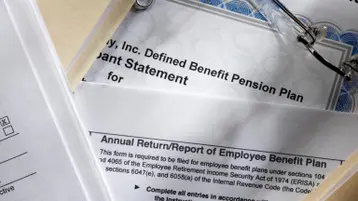
Table of contents
- 1.Defining FSA and HSA
- 2.What is a flexible spending account (FSA)?
- 3.What is a health savings account (HSA)?
- 4.Benefits of FSAs and HSAs
- 5.Health care cost savings
- 6.Tax benefits
- 7.Potential for retirement savings
- 8.Key differences between HSAs and FSAs
- 9.Eligibility requirements
- 10.Contribution limits
- 11.Use of funds
- 12.Rollover of unused funds
- 13.Tax implications
- 14.Make the right choice between FSA vs. HSA
When it comes to employment, health care coverage ranks right up there with salary and retirement benefits in terms of importance. Organizations may offer various choices for their employees’ healthcare coverage. Which one an individual should choose depends on their specific family, needs and goals.
Deciding between flexible spending accounts (FSAs) and health savings accounts (HSAs) is often an important choice for employees. Understanding what each offers and how they differ is essential for making an informed decision.
This article explores some common threads and the primary differences between FSAs vs. HSAs to help you better understand which is right for you.
Defining FSA and HSA
Before you can compare FSAs and HSAs, you need to know what each one offers and how each works. Only then can you reach an informed decision about which is best for you.
What is a flexible spending account (FSA)?
A flexible spending account is a health care savings plan that an employer sponsors for its employees as part of the benefits package. The funds you place into the FSA account, along with the interest on the account, are tax-free. Employees can use these funds to help pay for eligible medical expenses such as copayments, deductibles and some drugs.
What is a health savings account (HSA)?
A health savings account is for employees who have a high-deductible health plan (HDHP). Employers who provide HDHPs often offer HSA accounts to help offset the health insurance plan's higher deductible.
Benefits of FSAs and HSAs
Several similarities exist between FSAs and HSAs. Both offer employees such compelling advantages as:
Health care cost savings
Both account types allow an employee to deposit pre-tax dollars (money that hasn’t had taxes taken out of it yet). Withdrawals are also not taxed, which helps the employee save money on health care costs.
Tax benefits
Speaking of taxes, by contributing to FSAs or HSAs with tax-free dollars, employees can sometimes reap considerable tax benefits. First, they don’t pay taxes on their contributions. Also, if the employer makes contributions, employees don’t pay taxes on that amount, either.
Potential for retirement savings
Using these accounts as vehicles to save money on health care expenses frees up dollars to put toward retirement savings.
Key differences between HSAs and FSAs
While there are some overarching similarities between the two, HSAs and FSAs are different animals in several essential ways.
Eligibility requirements
Being eligible for an HSA is different from eligibility for FSA in that an HSA requires enrollment in an HDHP. In 2023, the minimum deductible for an HDHP is $1,500 for an individual or $3,000 for a family. An FSA requires you to be enrolled in the plan through your employer.
Contribution limits
Another difference that may impact which plan employees choose involves how much they can contribute. HSAs may have higher contribution limits than FSAs.
FSA plans require the employee to determine how much they will contribute at the beginning of the year. Funds are deposited into the account through payroll deductions. Employees can make HSA contributions up until the tax deadline for the year the contributions were made.
HSA contribution limits for 2024 are $4,150 for individual coverage and $8,300 for family coverage. Employees 55 or older can also make a catch-up contribution of up to $1,000 per year.
The FSA maximum contribution limit in 2024 is $3,200.
Use of funds
FSAs and HSAs have different requirements regarding how funds can be used.
HSA and FSA funds can be used to cover qualified medical expenses. Some examples include copayments, deductibles, certain drugs, medical equipment and diagnostic testing.
A health care FSA can be used to cover dental and vision expenses.
Once the employee turns 65, they can use HSA funds for non-medical expenses. However, using it for non-medical expenses means that it will be taxed as income at your current tax rate.
Rollover of unused funds
A big difference between FSAs and HSAs is in how the fund can (or cannot) be rolled over from one year to the next.
Employees can carry over HSA funds. An employee’s remaining balance carries over to the next year with an HSA. There’s no worry about losing money with this plan. There's no need to rush at the end of the year to spend the remaining amount. This means that it can be saved for future medical needs as you age.
Employees cannot carry over FSA funds. Operating on a “use-it-or-lose-it” premise, employees can carry over up to $610 of unused funds (the employer determines the amount). Any other money in an FSA plan reverts to the employer.
Employees may have a grace period available to them. If so, they will have up to 2 ½ months after the plan year ends to spend their FSA balance.
Tax implications
Since nobody wants to pay more income taxes than required, understanding how FSAs and HSAs deal with taxes is crucial.
HSAs allow employees to make tax-free contributions and use pre-tax funds to pay for medical expenses. HSA funds can grow year over year and be used once the employee turns 65. At that time, the employee will need to pay the regular tax rate but will incur no penalties.
FSAs also permit pre-tax contributions and tax-free withdrawals to cover medical expenses. However, the funds aren’t invested year after year. The balance is lost if it isn’t used (unless the employer opts for a carryover or grace period feature).
Make the right choice between FSA vs. HSA
Before deciding on an FSA or an HSA, employees must carefully weigh each option against their individual circumstances.
Employers seeking more detail and guidance can trust TriNet to help. Speak with a knowledgeable representative today to begin building a better employee benefits package.
TriNet Team
Table of contents
- 1.Defining FSA and HSA
- 2.What is a flexible spending account (FSA)?
- 3.What is a health savings account (HSA)?
- 4.Benefits of FSAs and HSAs
- 5.Health care cost savings
- 6.Tax benefits
- 7.Potential for retirement savings
- 8.Key differences between HSAs and FSAs
- 9.Eligibility requirements
- 10.Contribution limits
- 11.Use of funds
- 12.Rollover of unused funds
- 13.Tax implications
- 14.Make the right choice between FSA vs. HSA






